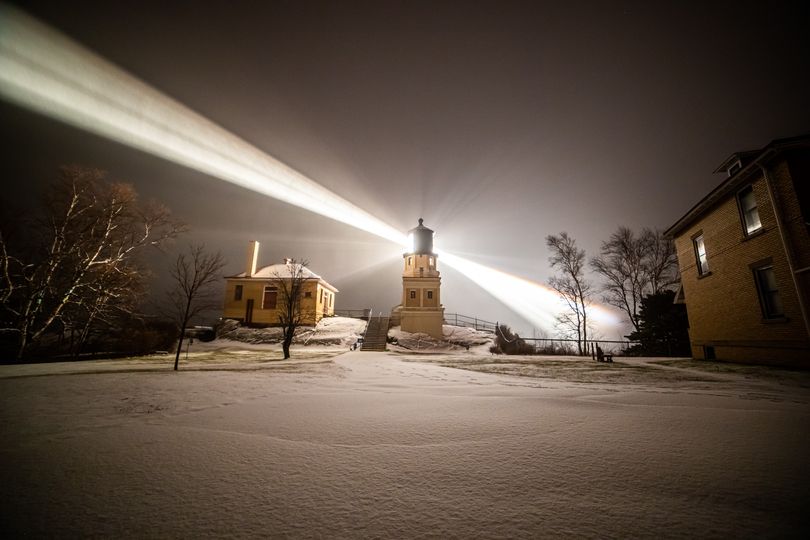Hayes Scriven has a priceless view of perhaps’s America’s greatest lake — Superior. It’s a view that captivated Scriven as a student at the University of Minnesota – Duluth, where he majored in history. After working in a museum in southern Minnesota for 12 years, he moved his young family back to the North Shore, where he became the first site manager for Split Rock Lighthouse (https://www.mnhs.org/splitrock) in 36 years. Scriven shared his story, and the story of the 115-year old lighthouse (which was decommissioned in 1969 but serves as a historical destination for tourists) in a series of presentations, “Gales of November,” sponsored by Lake Superior Magazine earlier this month. One of those classic gales in 1905 caused the wreck of 30 ships overloaded with iron ore in the vicinity of Split Rock, which the Minnesota Historical Society refers to as “the most dangerous piece of water in the world.”
Raised in a small inland town, Scriven unknowingly visited Split Rock at age 2 — a photograph of which his mother showed him for the first time after he decided to move there. He visited several times before his college years, but that’s when he knew he found home. He told coworkers at his previous museum job that there was only one place he’d move — Split Rock.
For him, it’s about history and the water: “There’s a phrase that a lot of of people up on the Shore use…a thing we call ‘North Shore magic’: You look at something and you have this feeling, this weird connection to a place.” It’s difficult for him to explain: a sense of calm, peace, “an all around good feeling…If you spend continuous time near the water, especially Lake Superior, there’s something that gets into you and you just can’t get it out of you.”
While in college he spent a lot of free time by the water. In fact, he proposed to his future wife on a hill overlooking the lighthouse. “Every time I came to visit the North Shore it felt like I was home again… That draw was still there.”
The lighthouse is situated on the edge of a 168-foot anthracite cliff; the light tower rises another 60 feet. Scriven likes to kayak in the waters off Split Rock. “Being in a kayak is a different type of feeling,” he says. “You’re so much closer to the water. You can develop a better connection.” The historian is also fascinated with what he can see 40 feet below him. He speaks of kayaking out to Gold Rock Point, about a half-mile out. There he can see one of the ships that went down in 1905 in the clear, cold water. “To have that kind of connection, that feeling of the lake, to see that history up close and see how big that ship was and how smashed it is puts into perspective how tiny you really are on the lake…you can see its power there.
There are 140 lighthouses along the Great Lakes, more than any other region in the United States. Julie E. Smith, who writes the blog, American Trekker (http://americantrekkerblog.com), explains the “enigma” of lighthouses: “To so many people, myself included, there is a sustained fascination with both the buildings themselves and the stories behind the ‘keepers of the light.’ Lighthouses are not just little buildings by the water, they also have provided avenues of both historical and architectural study.” Additionally, she says, lighthouses are a cultural symbol that “provide guidance and inspiration to weary souls, referenced to as such in both literary works and popular culture. In terms of symbolism, there is a dichotomy that exists between the isolation of the lighthouse keeper and their job requiring them to have a connection; a contact with the outside world. That is why I, and perhaps others, feel such a connection to lighthouses. I sometimes feel a sense of isolation, but at the same time believing (hoping) that I am part of the community and part of something bigger. It’s good to think we are all a part of something larger in the scheme of things.”
The coronavirus pandemic has forced nearly everyone to adopt some form of isolated living, working, and learning situation. Lighthouses, historically, and even to some extent today, represent the ultimate example of isolated living. In fact, the Split Rock Lighthouse was only accessible by boat for many years, until Highway 61 was constructed along the Lake Superior shoreline. Scriven comes from a small town, so the isolation of Split Rock isn’t an extreme departure. Still, he finds that the relative solitude fortifies his sense of self and allows for a nearly stress-free lifestyle. It offers his children “a better appreciation for the world around them. Seeing the beauty in nature and appreciating the environment more…just developing a deeper connection with the outdoors instead of material things.”
Unlike many in his generation who change jobs on a whim, Scriven feels settled, like his predecessor. “I don’t see myself going anywhere else.”
Photo of the Split Rock Lighthouse, Nov. 10, 2020, during the Edmund Fitzgerald Beacon Lighting, courtesy of Hayes Scriven
